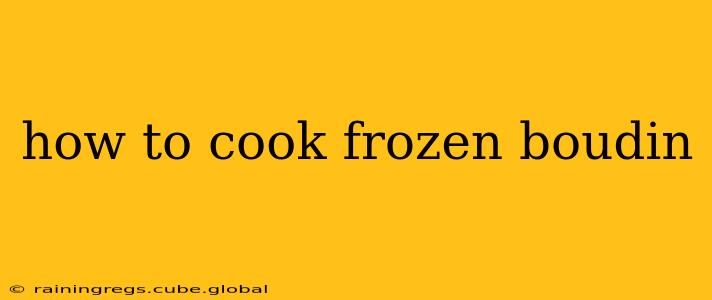Boudin, that delicious Cajun sausage, is even better when you know how to cook it perfectly, especially when starting from frozen. Whether you're craving a quick weekday meal or preparing for a weekend feast, this guide will walk you through various methods for cooking frozen boudin, ensuring a juicy and flavorful result every time.
How Long Does it Take to Cook Frozen Boudin?
The cooking time for frozen boudin depends heavily on the method you choose and the thickness of the links. Generally, expect a longer cooking time than with fresh boudin. We'll break down the timing for each method below.
Methods for Cooking Frozen Boudin
Here are several foolproof methods to cook your frozen boudin:
1. Boiling Frozen Boudin:
This is perhaps the simplest method.
-
Instructions: Place the frozen boudin links in a pot of boiling water. Ensure the water completely covers the boudin. Bring the water back to a boil, then reduce heat to a simmer. Simmer for approximately 20-30 minutes, or until the internal temperature reaches 165°F (74°C). Cooking times might vary depending on the size of the boudin links; larger links will require slightly more time.
-
Advantages: Simple, mess-free, and ensures even cooking.
-
Disadvantages: Boudin might absorb some water, slightly diluting the flavor.
2. Baking Frozen Boudin:
Baking results in a crispy exterior and a tender interior.
-
Instructions: Preheat your oven to 350°F (175°C). Place the frozen boudin links on a baking sheet lined with parchment paper. Bake for 30-40 minutes, or until the internal temperature reaches 165°F (74°C). For extra crispy boudin, you can broil it for the last few minutes, but watch carefully to prevent burning.
-
Advantages: Crispy skin, easy cleanup.
-
Disadvantages: Requires oven space and takes slightly longer than boiling.
3. Frying Frozen Boudin:
Frying gives you that satisfyingly crispy exterior many crave.
-
Instructions: Heat about ½ inch of oil in a large skillet over medium-high heat. Carefully place the frozen boudin links in the hot oil, ensuring not to overcrowd the pan. Fry for approximately 15-20 minutes, turning occasionally, until golden brown and the internal temperature reaches 165°F (74°C).
-
Advantages: Crispy exterior, flavorful.
-
Disadvantages: Requires oil, can be messy, and needs careful attention to prevent burning.
4. Air Frying Frozen Boudin:
Air frying is a healthier alternative to deep frying, delivering a crispy result with less oil.
-
Instructions: Preheat your air fryer to 375°F (190°C). Place the frozen boudin links in the air fryer basket, making sure they're not overcrowded. Air fry for 15-20 minutes, shaking the basket halfway through, until golden brown and the internal temperature reaches 165°F (74°C). Cooking time may vary slightly depending on your air fryer model.
-
Advantages: Crispy texture with less oil, faster than baking or frying in oil.
-
Disadvantages: Requires an air fryer.
How to Tell if Boudin is Cooked Through?
Regardless of the cooking method, always use a food thermometer to ensure the internal temperature reaches 165°F (74°C). This is crucial for food safety. Do not rely solely on visual cues like color or texture.
Can You Microwave Frozen Boudin?
While you can microwave frozen boudin, it's generally not recommended. Microwaving tends to result in uneven cooking and a less appealing texture. The exterior might be overcooked while the interior remains cold and undercooked.
What to Serve with Boudin?
Once your perfectly cooked boudin is ready, consider serving it with some classic Cajun sides: dirty rice, potato salad, coleslaw, or a simple green salad.
This comprehensive guide should give you the confidence to cook frozen boudin to perfection, no matter your preferred cooking method. Remember always prioritize food safety and use a meat thermometer to guarantee it's cooked thoroughly. Enjoy!
